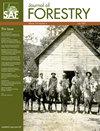在自然再生的香脂杉林中测试单个树风损害风险模型:间伐对风险水平的潜在影响
IF 3.2
2区 农林科学
Q1 FORESTRY
引用次数: 17
摘要
广泛分布于魁北克的香脂冷杉(Abies balsamea (L.)))极易受到风的破坏。最近,在森林管理方面有一种趋势,即在自然再生的林分中增加部分采伐的使用,使剩余的树木面临更大的风害风险。因此,为了限制部分插枝后的风害,重要的是要找到将这些冷杉林风害风险降至最低的造林方法。我们的主要目标是找到香脂冷杉特定的参数值,将其整合到风风险模型ForestGALES中,以模拟不同类型的商业间伐对风损害风险的影响,并确定哪种做法可能将自然再生林分的风险降至最低。放置在树冠高度的风速计和连接在香脂冷杉树干上的应变计使我们能够测量香脂冷杉树样本所经历的风致弯度。这样就可以计算出每棵树特有的弯矩系数,以便与ForestGALES模型的预测结果进行比较,并使该模型适用于香脂冷杉林。首先以树径和树高为输入变量计算弯矩系数,然后加入竞争指数,最后加入树冠尺寸。利用Wind Atlas Analysis and Application Program气流模型计算了用于预测损伤概率的风气候参数。然后使用精度最高的模型来模拟两种类型的间伐,并确定对林分中每棵树的风害风险的影响。根据该模型的预测,与从上面变薄相比,从下面变薄的风灾风险更低。本文章由计算机程序翻译,如有差异,请以英文原文为准。
Testing an individual tree wind damage risk model in a naturally regenerated balsam fir stand: potential impact of thinning on the level of risk
Widely distributed in Quebec, balsam fir (Abies balsamea (L.) Mill.) is highly vulnerable to wind damage. Recently, there has been a trend in forest management to increase the use of partial cuttings in naturally regenerating stands, leaving the remnant trees at increased risk of wind damage. In order to limit wind damage after partial cuttings, it is therefore important to find silvicultural practices that minimize the risk of wind damage in these fir stands. Our main objective was to find balsam fir-specific values of parameters to integrate into the wind risk model ForestGALES, in order to simulate the impact of different types of commercial thinning on wind damage risk, and to determine which practice potentially minimizes the risk in a naturally regenerated stand. An anemometer placed at canopy height and strain gauges attached to the trunks of balsam firs allowed us to measure the wind-induced bending moments experienced by a sample of balsam fir trees. This enabled the calculation of the turning moment coefficients specific to each of the trees in order to compare them with the ForestGALES model predictions and to adapt the model for balsam fir stands. The model was tested first with only tree diameter and height as input variables to calculate the turning moment coefficient, then with the addition of a competition index, and finally with the addition of crown dimensions. Wind climate parameters for prediction of the probability of damage were calculated using the Wind Atlas Analysis and Application Program airflow model. The model with the highest accuracy was then used to simulate two types of thinning and determine the impact on wind damage risk for each tree in the stand. According to the model’s predictions, thinning from below has a reduced risk of wind damage compared with thinning from above.
求助全文
通过发布文献求助,成功后即可免费获取论文全文。
去求助
来源期刊

Forestry
农林科学-林学
CiteScore
6.70
自引率
7.10%
发文量
47
审稿时长
12-24 weeks
期刊介绍:
The journal is inclusive of all subjects, geographical zones and study locations, including trees in urban environments, plantations and natural forests. We welcome papers that consider economic, environmental and social factors and, in particular, studies that take an integrated approach to sustainable management. In considering suitability for publication, attention is given to the originality of contributions and their likely impact on policy and practice, as well as their contribution to the development of knowledge.
Special Issues - each year one edition of Forestry will be a Special Issue and will focus on one subject in detail; this will usually be by publication of the proceedings of an international meeting.
 求助内容:
求助内容: 应助结果提醒方式:
应助结果提醒方式:


